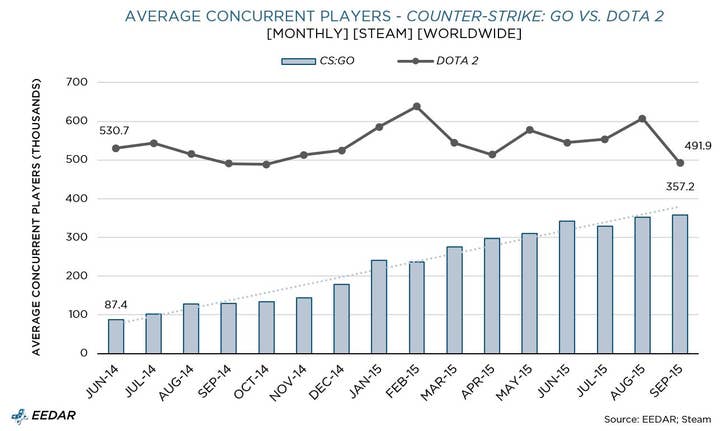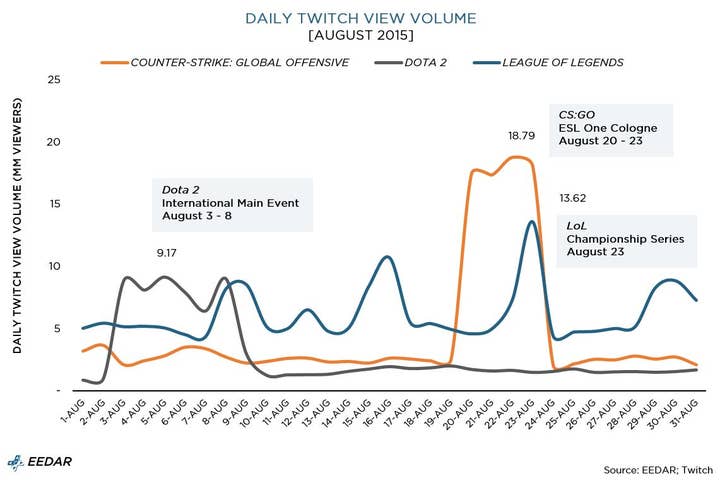How Counter-Strike: Global Offensive is still dominating Steam
EEDAR VP of Insights Patrick Walker on why CS:GO is the epitome of games as a service done the right way
Although Counter-Strike: Global Offensive (CS:GO) has been continuously growing since its August 2012 release, it was not until late 2014, more than two years post-launch, that the title really started to explode. Since that time, the monthly average number of concurrent players has more than tripled from around 100K in late 2014 to consistently over 300K since summer 2015.
This rapid growth not only makes CS:GO far and away the second most-played title on Steam, but also puts the title's player engagement in the ballpark of Dota 2, which has dominated Steam play since its rapid growth period in 2013.

As the graph above shows, in September 2015 the number of average concurrent Counter-Strike players moved to within 150K of that of Dota 2. This growth in CS: GO active users is especially impressive because unlike Dota 2, the title is not free-to-play, instead having an initial price of $14.99. This means that while the number of overall owners is significantly lower than the F2P Dota 2, the percentage of owners that are active players is significantly higher. As of October 2015, almost half (43 percent) of CS:GO owners had played in the past two weeks, a much higher percentage than most Steam games, including Dota 2 (8 percent).

There are many reasons behind the success of CS:GO, including the built-in fan base of the original Counter-Strike games and consistent first-party advertising to Steam's 150 million active users. However, it is noteworthy that the game's success has built steadily over the course of three and half years. CS:GO is the epitome of a successful game as a service (GaaS) - the product has evolved over time to meet the needs of a diverse community.
Much of the rapid growth of CS:GO can be attributed to how the product meets the needs of different segments of the community, including highly competitive players and professionals, content creators, and tournament viewers:
CS:GO is consistently updated to balance competitive play. While a GaaS must provide content updates over time to fuel growth, it is critical to make sure updates satisfy the most engaged players. Valve has done a good job of listening to the high-level tournament community and using feedback from this group to implement game updates. Examples of competitive balance updates from the past year include slowing the rate of sniper rifle fire and increasing the amount that damage slows movement speed. While any change in gameplay will be polarizing, the overall reception to these changes from the professional community has been positive.
The CS:GO community is incentivized to continuously create high quality content. One of the challenges to operating a game as a service is the need to produce a steady stream of new content. One way to do this is provide the community with a platform to create user generated content (UGC). Valve creates an opportunity for map makers to gain revenue by contributing maps to "operations", which function like Valve's official map packs. This structure creates a system where high quality content is released on a continuous basis.
CS:GO provides an excellent experience for eSports viewers. CS:GO has benefited from the rapid growth of an eSports community that lacked a dominant shooter until CS:GO took the mantle. CS:GO has been successful as an eSport for several reasons. First, the Counter-Strike franchise has a long history of professional play. Second, the CS:GO match structure, a long series of rounds with resource purchase between rounds, adds a strategic element that adds depth to the viewing experience. Viewers are able to follow the strategic meta-game across rounds in addition to round-by-round action and individual performances. Finally, CS:GO has also done an excellent job of incentivizing viewership by linking players' Steam and Twitch accounts and creating viewing rewards that tie back to the players' CS:GO accounts.
During the month of August, the highest Twitch viewership occurred during the ESL One, a major CS:GO tournament. This is especially impressive considering August also featured major tournaments for Dota 2 and League of Legends.

One of the major trends in the industry is the rise of the GaaS business model. When done well, the model can provide growing engagement and consistent revenues over a long period of time. However, running a successful GaaS business model requires consistently meeting the needs of multiple segments of a game's community. CS:GO provides many best in class examples of how to do this effectively.
The data in this article is from the recently released EEDAR eSports Consumer Analysis. For more information on the report, email solutions@eedar.com.
